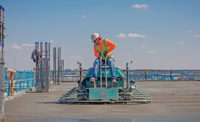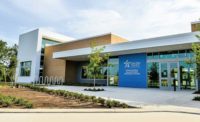On May 30, 1921, 17-year-old Sarah Page, a white elevator operator who worked in the downtown Tulsa Drexel Building, accused Dick Rowland, a 19-year-old Black shoeshiner, of assault.
Although she later recanted the charge, Rowland was jailed at the courthouse. An armed white mob—some newly deputized—gathered, and lynching rumors circulated. A group of black men, some with guns, twice gathered to prevent such an event. But a firefight flared and, as survivors reported, “All hell broke loose.”
On June 1, Oklahoma Gov. James Robertson declared martial law, and the National Guard ended the killing and the looting and burning of homes and businesses in the upscale Black community. As many as six planes owned by whites dropped incendiaries—perhaps the only instance in history of one group of Americans attacking another by air.
In the end, up to 300 were killed, 800-plus injured, $2.7 million in property damage incurred ($30–50 million in 2021 value) and thousands interned and homeless. The 1921 Tulsa Race Massacre had destroyed the 35 square blocks comprising “Black Wall Street,” one of the nation’s wealthiest Black communities.
On June 2, 2021, during the 1921 Tulsa Race Massacre Centennial weekend, the 11,000-sq-ft Greenwood Rising history center will be dedicated at 23 N. Greenwood Ave. on the southeast corner with Archer Street, the gateway to the resurging community. The $7.5-million one-story building is anchored by an exhibit hall celebrating the story of the Greenwood District. It opens to the public later in June.
“Greenwood is ground zero for historic racial trauma in this country. This history facility ... will become a place where healing from that trauma can begin a journey to racial reconciliation.”
— Phil Armstrong, TRMCC Project Director
The event will be hosted by the Tulsa Race Massacre Centennial Commission (TRMCC), formed in 2015 by Tulsa-born State Senator and Commission Chair Kevin Matthews. “We’re building a first-class history center that will tell all Americans and the world the story of that terrible massacre and, hopefully, will spur renovations and new buildings downtown and throughout North Tulsa,” says Matthews, a former firefighter and business owner who helped raise $30 million for the facility.
Roxanne Bell, one of Matthews’ relatives, recently died at age 102. She often told the story of how her parents hid her under a table during the siege. “The name Greenwood Rising affirms that after 400 years of African American history in this country, we have continued to rise after our community was burned down and destroyed,” Matthews adds.
The Tulsa office of Columbus, Kan.-based Crossland Construction Co., serves as construction manager for the center, which broke ground in August. It was designed by Selser Schaefer Architects in Tulsa. New York City-based Local Projects is completing the exhibit designs. The rest of the team is also Tulsa-based: Wallace Engineering, civil; 360 Engineering Group, structural; Philips + Gomez, MEP; Howell & Vancuren Inc., landscape architecture; HofferWaska Creative, environmental graphics; and Stonebridge Group, the owner’s representative.
The Pathway to Hope, a pedestrian walkway that begins near Greenwood Rising, is scheduled to open the weekend before the center. It is also a TRMCC project and is being built by Crossland Construction. It travels past ONEOK sports field and Interstate 244 to the John Hope Franklin Reconciliation Park, named for the noted Tulsa-born historian. The park opened in 2010 as a memorial to the massacre victims.
The $5-million pathway symbolically reunites Greenwood, which was further traumatized in the mid-1960s and early 1970s by the building of a highway that divided the community in the name of urban renewal.
“Greenwood is ground zero for historic racial trauma in this country,” says Phil Armstrong, project director. An Ohioan by birth, he moved to Oklahoma in 1997 after attending Central State University. “This history facility ... will become a place where healing from that trauma can begin a journey to racial reconciliation.”
Light, Strong panels
Crossland began construction on Oct. 30 and at peak has had 40–45 workers on the 14,500-sq-ft parcel, says Greg Smith, vice president of the firm’s Tulsa division. “The biggest challenge of this project is the schedule, which is very aggressive but critical as we need to complete the project for the 100-year anniversary of the 1921 Race Massacre,” he says.
The number of specialty materials and finishes also posed construction challenges, Smith adds. The center’s glass fiber reinforced concrete panels, which wrap the exterior, act as a rain screen and are articulated by the patterned black brick below, explains Stephen Dinnen, project architect with Selser Schaefer Architects.
The panels are lit in the cavities and can be controlled via phone or other electronic means to change the color and pattern of the lighting. Other exterior elements include a glass entrance and structural silicone glazing as well as an aluminum curtain wall that stands at the northwest corner of the building, he says.
GFRCs provide many benefits, explains Eric Sutliff, general manager for DeVinci Precast, the Oklahoma City-based manufacturer. Sun Valley Masonry, Stillwater, Okla., is installing them on site.
On average, large-scale panels tend to be about five times lighter than wet-cast concrete, compared by square foot. “The savings in weight allow for easier and less costly constructibility and often translate into shorter installation times,” he says.
The veneer also requires fewer resources: less sand and cement, less water, fewer chemicals, less fuel to transport—and “let’s not forget, fewer strained backs,” adds Sutliff.
The north facade expresses the resilience, vibrancy and revitalization of the Greenwood spirit, welcoming visitors to the pedestrian-friendly building and district with a quote from writer James Baldwin, explains Nathan Koob, principal-in-charge for Selser Schaefer Architects.
“The shaped GFRC facade, never touching the ground, captures light from within and creates a rising effect. The randomized panels reflect individualism and together represent a larger fabric symbolic of the community, and the lower textured masonry recalls the brick structures of the lost buildings of Black Wall Street,” he adds.
At night, the facade changes, with dramatic light representing a transformation from a business area to an entertainment district. Koob says: “The building comes to life as an illuminated beacon seeking to inform and inspire both present and future generations.”
The Greenwood Rising Lesson
Greenwood Rising will feature interactive exhibit/experiences that highlight Tulsa’s Greenwood District and examine race relations in the U.S.
Post-Civil War segregation helped create Black Wall Street and spur prosperity among its residents, explains Tulsa resident Hannibal B. Johnson, author of 10 books on Black history.
“They seized the opportunity to devise a closed market system that defied the myth of African American mediocrity,” he has written of those early Greenwood residents. “Over time, fear and jealousy swelled within the white community. African American success, including home, business and land ownership, precipitated increasing consternation and friction.”
This animosity helped spark the 1921 massacre. But by 1942 more than 200 black-owned businesses had made Greenwood prosperous again. “In subsequent decades, integration, urban renewal and economic changes sparked a prodigious decline in the Greenwood District,” Johnson notes. Integration removed black dollars from the community, and urban renewal became “urban removal.”
With the interstate completed in the early 1970s, the “Deep Greenwood” area languished; many properties came to be owned by the Tulsa Development Authority, not African Americans, Johnson says.
But in the last 15 years, the now-integrated community has become the focus of development and investment. Johnson has written: “No longer a Black entrepreneurial mecca, its new incarnation is that of a business, educational, recreational, cultural and entertainment hub.”
As visitors prepare to exit the LED-lit galleries, they will enter an amphitheater that solicits dialogue. “Because Greenwood Rising is a place for healing racial trauma, a place for people to begin the journey to reconciliation, they will be encouraged to sit and start discussion on issues that divide us,” Armstrong says, suggesting an example, “How do we get past the aftermath of George Floyd?’”
The valedictory space is a commitment chamber where visitors can do that; their statements will be permanently displayed on a wall of unity. “What can I do to change the way I think or to help change other people and their biases?” he asks. “When they leave, they can feel that they haven’t just looked back on the road but have begun to make the journey forward.”









Post a comment to this article
Report Abusive Comment